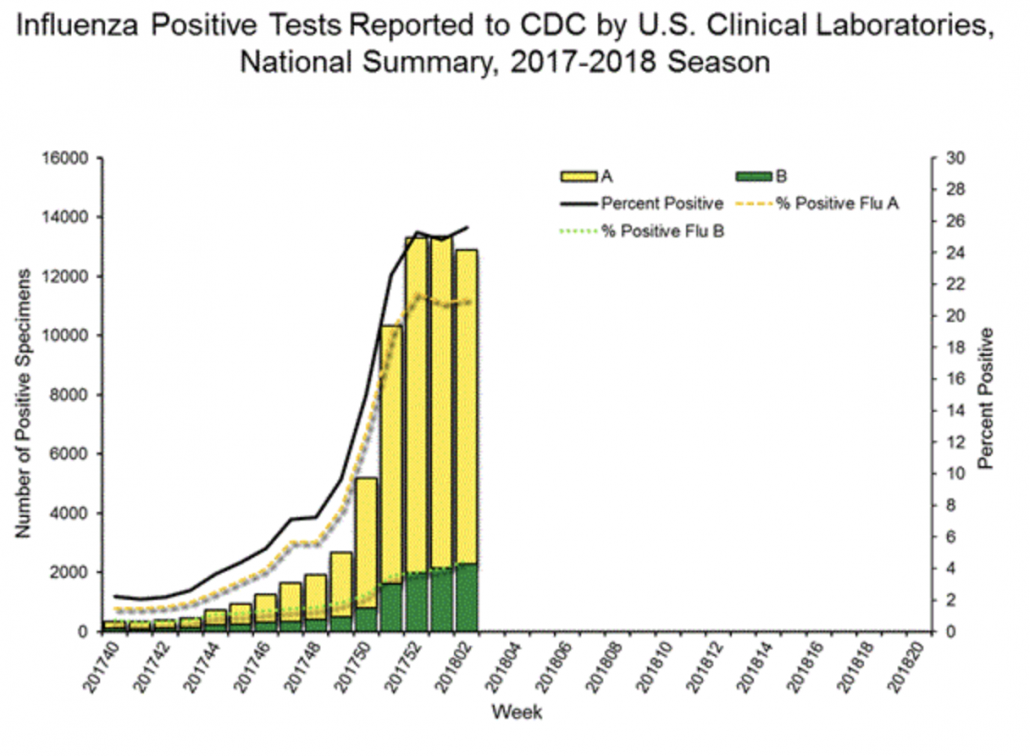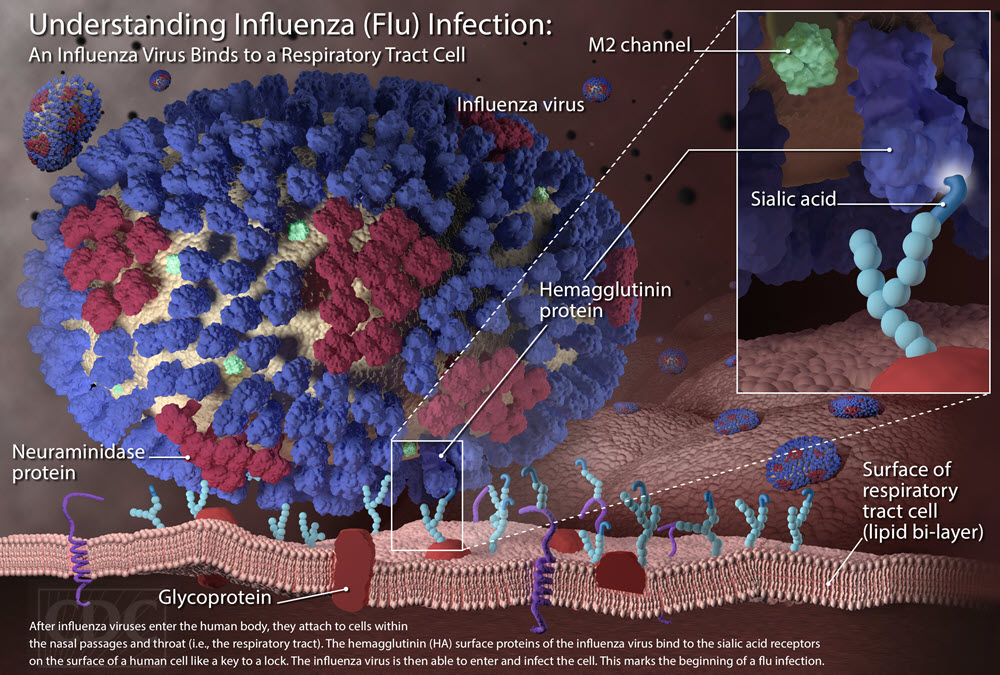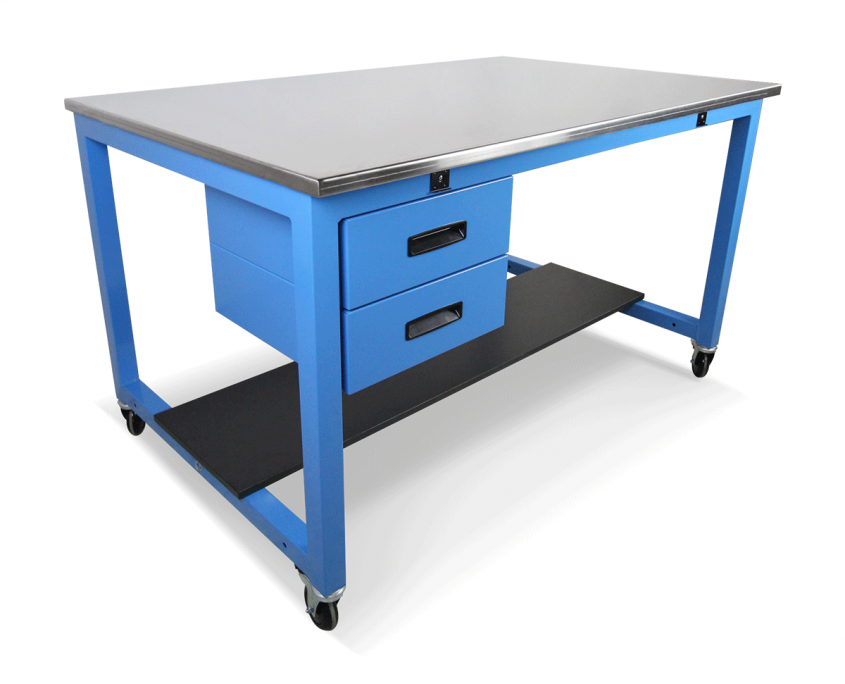Fever, coughing, aches and pains: coming down with the flu is no fun. But what if your entire office came down with influenza at the same time? Learn how to prevent a costly flu outbreak that could cripple productivity in your workplace.

Why is This Year’s Flu Season so Severe?
The seasonal flu season of 2017-2018 appears to be on track to be one of the worst outbreaks in recent decades. On Jan 12, 2018, the Centers for Disease Control (CDC) reported that 5.8% of all out-patient visits were for influenza-like illnesses, that flu hospitalizations had climbed to 22.7 per 100,000, and that all 48 states in the continental US were now reporting flu outbreaks at the same time (a new record).
The primary pathogen hitting us this year is H3N2, a form of influenza type A virus. The H3 viruses are notable for causing more severe flu outbreaks — resulting in more hospitalizations and more deaths.

But that’s not the only risk. At present, there are two additional viral outbreaks in the U.S. to watch out for according to the CDC’s weekly update. The first is Type B H1N1 influenza, which is capable of causing a serious case of flu whether one has been exposed to H3N2 or not. In addition, there are also lesser outbreaks of Influenza Type B/Yamagata in the U.S. Illnesses caused by this virus are typically less severe than those caused by Type A H3N2 or Type A H1N1, but it’s more contagious, so wash your hands!
Given that there are still 11 – 12 more weeks to go in the season, this year’s outbreak could turn out to be as bad as the “severe” flu years of 2014-2015 and 2003-2004. The CDC reports that people older than 65 and those younger than 5 were being hospitalized at high rates, followed by those aged 50-64. Tragically, there are many reports of deaths, even among seemingly healthy young adults.
The Negative Effect of Flu on Businesses and the Overall Economy
What’s the economic effect of seasonal flu on the U.S. Economy? In a 2007 research paper (The Annual Impact of Seasonal Influenza in the US: Measuring Disease Burden and Costs), investigators from the CDC found that (in an average seasonal influenza year) the total economic cost was $87.1 billion dollars.
Annual losses from influenza caused:
- $16.3 billion in lost earnings due to illness and premature deaths
- $10.4 billion in direct medical costs
- 1 million hospital days
- 4 million outpatient visits
- 610,660 life-years lost
The research firm Challenger Gray asserts that this year’s increased flu activity could result in employers facing record productivity losses this year. Based on last year’s flu statistics, Challenger Gray calculated the estimated number of workers (60% of the adult population) who will come down with the flu this year to be 11 million people. For this calculation, it was also assumed that each ill employee would be out of work four full 8-hour workdays (on average) — for a total of 352 million lost work hours. Multiplying that figure by the average US hourly wage ($26.63), Challenger Gray estimates that the total lost wages for the 2017-2018 flu season will total over $9 billion dollars ($9,415,586,823.84 to be exact).
Personal Health Checklist: Five Ways You Can Protect Yourself from Contracting the Flu

Here are the five key steps you can take to help prevent coming down with flu:
1. Get a Flu Shot Today
A flu shot not only helps protect you against this season’s flu viruses, it helps protect those around you (a concept known as “herd immunity”) who are at increased risk of contracting influenza, including seniors over 65 and children under 5.
Check with your employer or health plan to see if you can have a flu shot at no cost; many employers and carriers will reimburse you. Oftentimes, you can go to a national chain for your flu shot, including:
If you or someone you know doesn’t have health care coverage (or you don’t have time to go to your health care provider), the national chains listed above also offer low-cost flu shots.
Remember, the flu shot takes about 2 weeks to become effective, so the sooner you get one, the more protection you will have.
2. Avoid Exposure to Flu Germs
Wash your hands thoroughly several times a day for a full minute using hot water and soap, or by using gel-based hand sanitizers. Avoid touching your eyes, nose, or mouth, which can transfer germs. Consider avoiding shaking hands with others for the duration of the flu season to avoid passing germs.
If you or someone you work with starts coughing and sneezing, it’s a sign they should go home immediately and monitor their temperature. If they come down with signs of the flu (see a list of symptoms below), it’s likely they have been contagious for a full 24 hours prior to the onset of a cough. Avoid close contact with those who are ill or have been exposed to the virus to prevent the flu from spreading.
Those who become sick with flu need to stay home for the duration, typically a week or so, plus an additional 24 hours after the fever clears to avoid spreading the disease. If you have flu (or are taking care of family members who are ill), please don’t return to work — a phenomenon known as presenteeism — as it will only make the flu situation in the workplace worse. If you need to visit the doctor or pharmacy, get and wear a mask to protect those around you.
3. Beware of Germ Hot Spots
Germs can spread through the home or office quickly. In a study presented at the Interscience Conference on Antimicrobial Agents and Chemotherapy (ICAAC), researchers used a non-lethal proxy virus (bacteriophage MS-2) to measure how fast virus samples placed on doorknobs and table surfaces can spread in an office. The answer? Within two to four hours, the virus samples had spread to between 40 – 60 % of commonly touched items in the office, including light switches, telephones, tables, and sink taps.
Pay special attention these germ “hot spots” for transferring organisms.
- Keyboards & mice
- Mobile phones and telephones
- Light switches
- Table and desk surfaces
- Bottom surface of purses or small bags (avoid placing them on the floor or on a desk, which can transfer germs)
- Kitchen mess
- Elevator banks
- Common areas, such as break rooms
4. Kill Germs at Home and in the Office
Flu season means it’s time to change your cleaning habits to prevent the spread of flu.
Do not use kitchen sponges (and other reusable cloths) to clean surfaces. Sponges and cloths can actually spread pathogens from one area to another.
Instead, switch to disposable wipes, such as paper towels or single-use disinfectant wipes, to clean germ “hot spots” in common areas, including kitchens, break rooms, desks, phones, and keyboards.
While chlorine-based disinfectants are effective, you can follow the advice of the researchers in the virus study who recommend using Quaternary-based, EPA-approved disinfectants on frequently touched surfaces. Commonly known as Quats, these disinfectants are formulated with positive-charge surfactants, which cause them to attach to the outer surface of pathogens (which have a negative charge). The active ingredient then breaks down the cell walls, destroying virus and bacterium pathogens in a few minutes. Check out the Clorox brand of quaternary-based professional products that are used sanitizing healthcare facilities.
5. Stay Healthy
If you are stressed, not getting enough rest and exercise, or eating poorly, you may be more at risk for coming down with the flu.
Now is the time to build up your immunity. Eat balanced, nutritious meals, take vitamin C supplements, and get sufficient rest.
If you feel tired, listen to your body. Don’t push yourself. If you feel run down, sleeping for 10 – 12 hours might make the difference between a mild case of the flu (or avoiding it altogether) and a very uncomfortable week-long illness.
Office Manager’s Guide to Preventing Flu Outbreaks at Work
A major outbreak of flu could spell major disruption in your office. Don’t let it happen to you. Here are five recommended steps you can take now to prevent an influenza outbreak at work:
1. Implement a Flu Shot Campaign
Work with your insurance carrier or local organizations to promote a Flu Shot Day at work. Several national chains, including CVS, RiteAid, and Kroger, offer programs to bring health care professionals to your facility to administer flu shots to your employees.

The CDC also has extensive resources to help you promote your flu shot campaign, including printable brochures and posters to promote the event.
2. Discourage Presenteeism
Employees who continue to show up to work with signs of the flu or who are taking care of sick family members at home pose a great infection risk to other workers. Offer employees the opportunity to stay home without the threat of losing their jobs. Allow parents to stay home to take care of sick kids. Employees who begin to show signs of a cough should be sent home immediately; they may have been contagious for up to 24 hours before the onset of a cough or fever and will remain contagious for the duration of the illness — plus 24 hours after the last signs of fever.
3. Change Employee Behavior
Encourage telecommuting when possible.
Discourage handshaking during the height of flu season.
Frequently wash or disinfect hands with gel sanitizers.
Avoid touching your mouth, nose, and eyes, especially after visiting germ “hot spots” (listed above).
Encourage exercise, stress reduction, proper sleep, and good nutrition to avoid illness.
4. Step Up Sanitation Efforts
Don’t use kitchen sponges and reusable cloths for clean up. Switch to single-use paper towels or sanitary wipes.
Provide disinfecting wipes for the germ “hot spots” listed above, paying special attention to commonly touched items, such as mobile phones, keyboards, doorknobs, and common surfaces.
Invest in professional Quaternary-based, EPA-approved disinfectants used to sanitize healthcare facilities. These “quat” products, such as the Clorox brand of quaternary-based cleaners, provide more protection against flu virus than bleach-based cleaners.
5. Take Preventative Measures
In addition to providing disposable clean-up wipes and using Quat-based disinfectants, you should consider these items to make your facility more resistant to the spread of germs:
Desk and work surfaces: Formaspace offers germ-resistant furniture products. Ask our Design Consultants about furniture made using Formica new germ-resistant brand laminate, as well as stainless steel or maple surfaces, both of which are also germ resistant.
Install hooks under desks, tables, and in restroom stalls: small bags or purses which sit on the floor and later on desk or table surfaces are a major source of germ transfer. Install convenient hooks or pegs to make it convenient to avoid placing bags or purses on floors or desks. Encourage employees to use them.
Purchase no-touch garbage cans and no-touch hand sanitizer stations. These should be placed in common areas, such as entry corridors, elevator banks, common areas or workstations.
Provide vitamin C tablets for employees. Also, provide temporary face masks for employees who start coughing and need to go home.
What Can You Do if You Get Sick with the Flu?
If you or a family member or co-worker begin to experience a high fever, runny nose, sore throat, muscular pain, headache, coughing or fatigue, you could be coming down with the flu. If so, it’s likely that you’ve already been contagious for the previous 24 hours, and you will continue to be a risk to those around you for the duration of the illness, which typically lasts a week (although a cough can continue for up to two weeks). Don’t consider yourself free of contagion until a full 24 hours have passed since your temperature has returned to normal.
Serious complications of influenza may include viral pneumonia, secondary bacterial pneumonia, sinus infections, and worsening of previous health problems, such as asthma or heart failure.
A common misconception is that antibiotics can cure the flu. Not only is this wrong (antibiotics are only effective against bacterial infections, not viral ones), unnecessary misuse of antibiotics can increase the risk of antibiotic-resistant infections in the future.
Make a call to your healthcare provider for treatment recommendations. For mild cases of flu, rest, plenty of fluids, and over-the-counter pain medications that treat the symptoms may be the best course of action.
Sicker patients or those at higher risk, including children under 5 and seniors over 65 may need more proactive care or even hospitalization. In these cases, the doctor may prescribe a flu antiviral. According to the CDC, there are now several on the market, including Tamiflu, Oseltamivir, Zanamivir, and Peramivir, that are effective at treating this year’s flu strains. (Consumer Reports has also investigated anti-flu medications.)
Once again, please remember that if you come down with flu you are contagious to others for the duration of your illness, plus an additional 24 hours after the last signs of fever, so take care not to spread your germs.
Take Care of Yourself, Your Family, and Your Workplace
We hope this guide to surviving this year’s flu season will help protect you and those around you from experiencing a serious flu outbreak. We have taken these precautions ourselves, including an on-site flu shot campaign, here at our Formaspace factory headquarters.
Talk to your friendly Formaspace Design consultant about our germ-resistant furniture products. We offer easy-to-clean, germ-resistant furniture products, including those made with Formica brand germ-resistant laminate, as well as stainless steel and solid maple surfaces.

Make contact with us today. Just fill out the quick contact form below.










